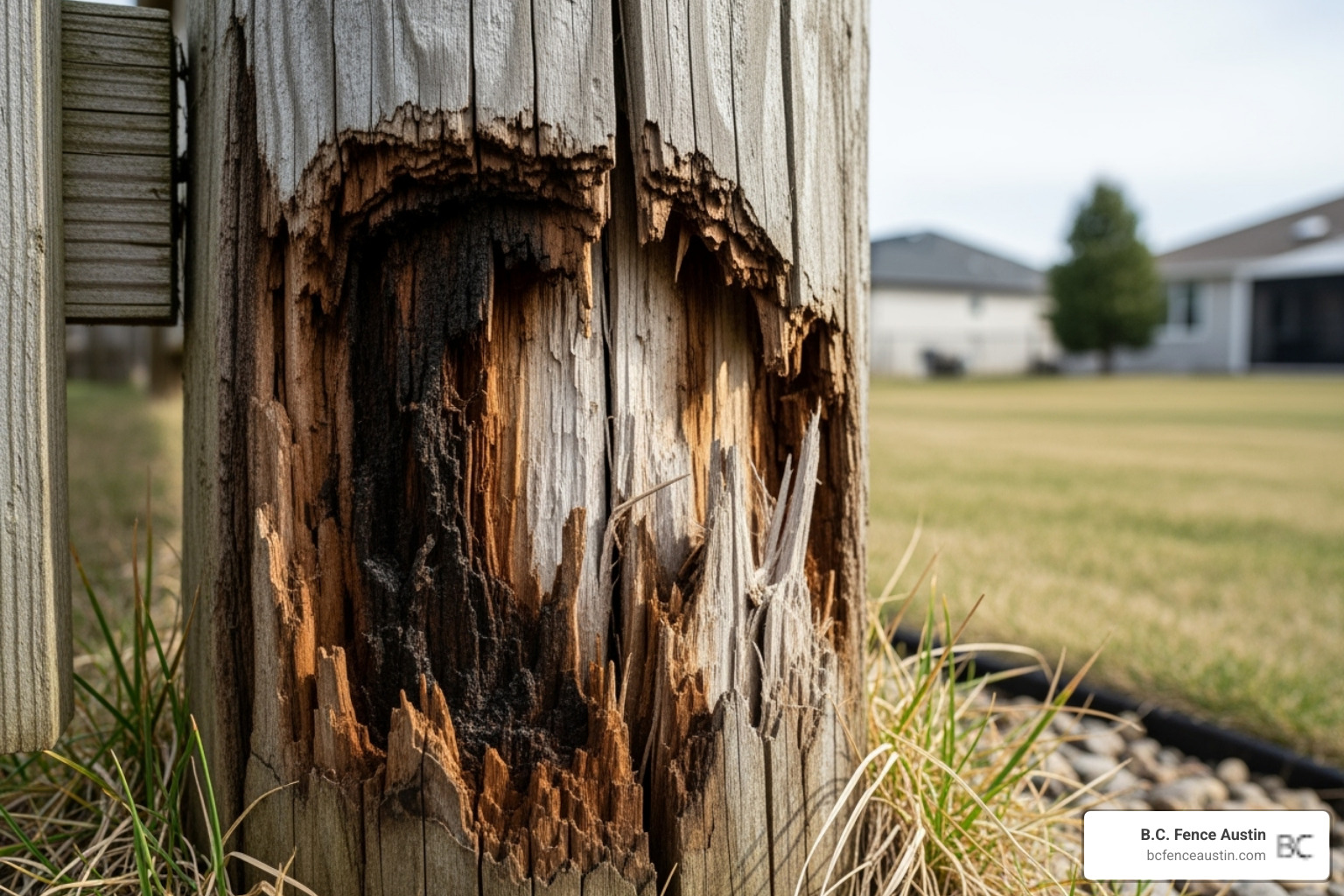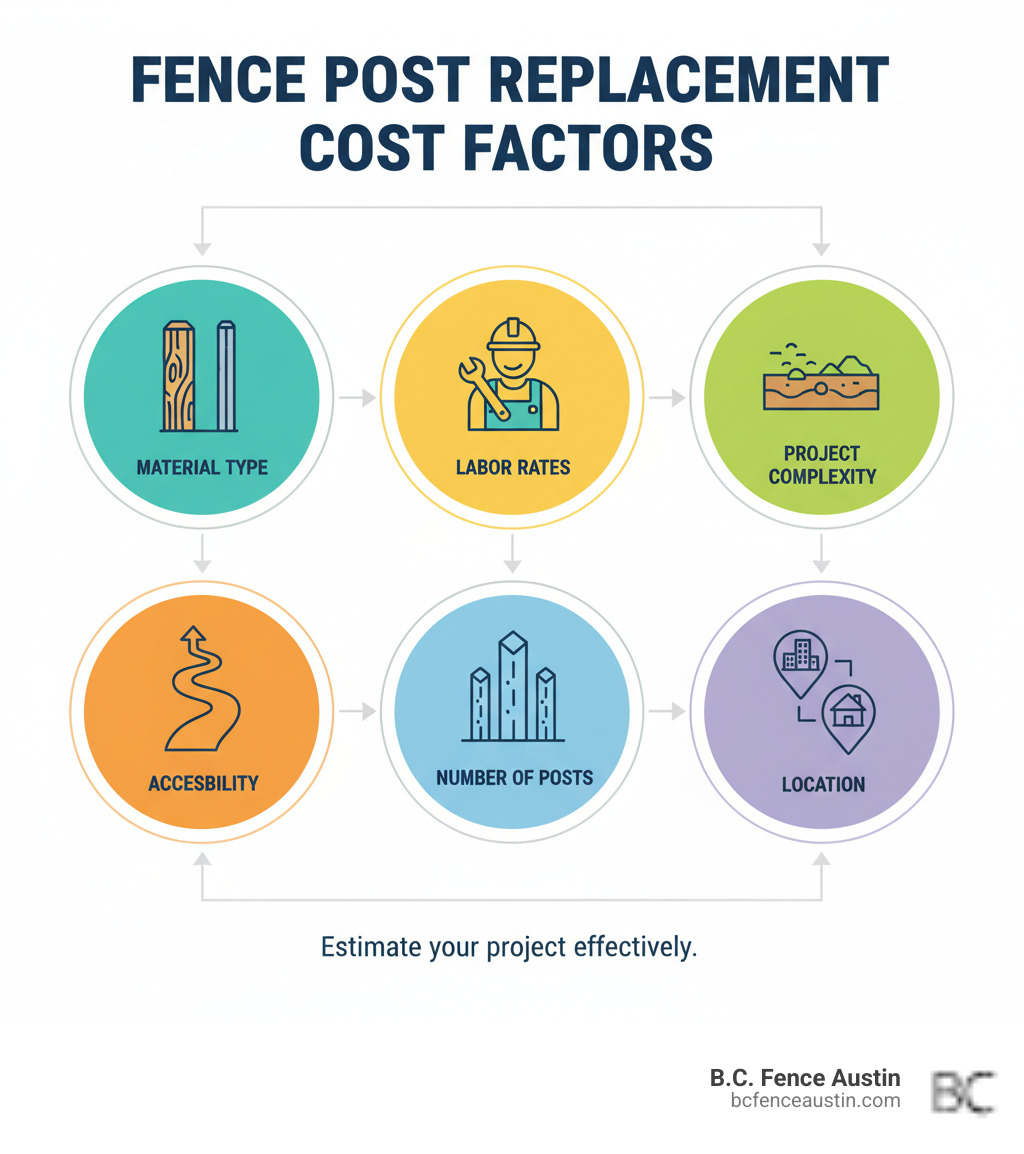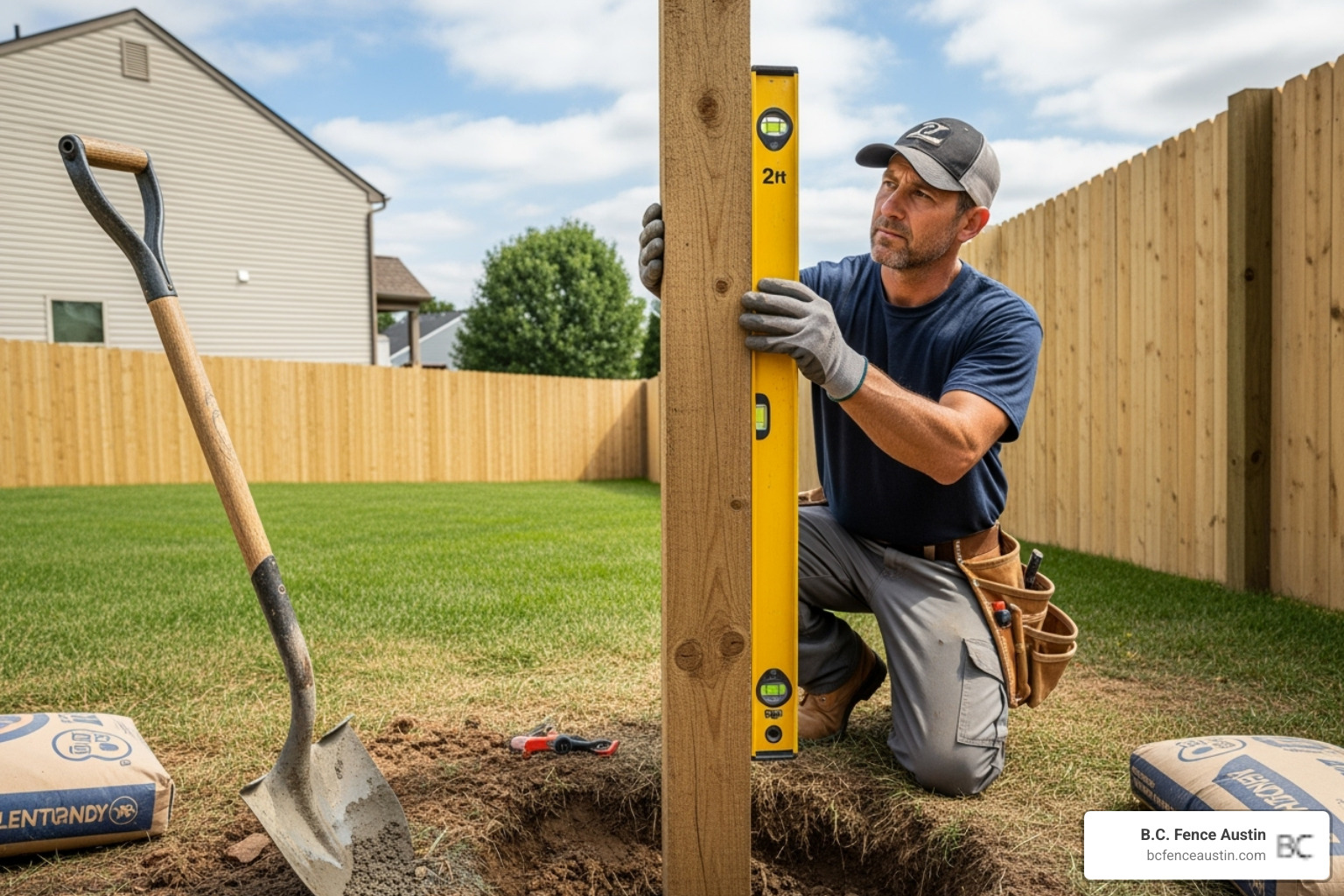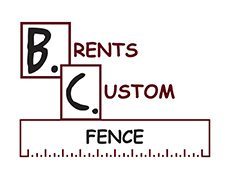Why Understanding Fence Post Replacement Cost Matters

Fence post replacement cost depends on several key factors, and knowing what drives the expense helps you budget effectively. Here’s what you need to know:
Quick Cost Breakdown:
- Material Type – Wood posts differ significantly from metal, vinyl, or composite options
- Labor Charges – Professional installation typically accounts for a significant portion of total expenses
- Project Complexity – Difficult soil, accessibility challenges, and old concrete removal add to the bill
- Number of Posts – Single post repairs are simpler than multiple post replacements
- Location – Urban areas generally command higher rates than rural locations
- Additional Expenses – Permits, disposal fees, and site preparation can increase the total
A wobbly or broken fence post is more than an eyesore. It compromises your property’s security, privacy, and overall stability.
Many homeowners delay this crucial repair, unsure of the process and the factors that determine the expense. According to industry research, fence post replacement typically ranges from a modest repair to a significant investment, depending on the material, labor requirements, and site conditions.
The reality is that fence posts provide critical support for panels and rails. When they fail, your entire fence system is at risk. A leaning post today can become a collapsed fence section tomorrow, especially after Austin’s occasional severe weather.
This guide demystifies the process, breaking down everything you need to know to budget for a fence post replacement. You’ll learn how material choices affect longevity, when DIY makes sense versus hiring a professional, and how to determine if a single post repair is sufficient or if a larger replacement project is the smarter investment.

The Core Factors That Influence Fence Post Replacement Cost
The final bill for replacing a fence post isn’t a single number but a sum of several key variables. Understanding these components is the first step to accurately estimating your project’s expense.

What Determines the Fence Post Replacement Cost?
Think of your fence post replacement cost as a puzzle with several pieces that all fit together. The biggest piece? The material you choose for your new post. A basic wood post carries a different price tag than pressure treated wood for fencing offers superior durability, and both differ significantly from metal or vinyl options.
Labor rates make up another substantial piece of the puzzle. The skill and experience of the crew doing the work directly impacts what you’ll pay. Then there’s project complexity—is this a straightforward replacement, or are we dealing with difficult terrain, stubborn old concrete, or tricky access issues? These challenges can turn a simple job into a more involved project.
Your geographic location matters more than you might expect. Austin’s market conditions, local labor availability, and regional material costs all play a role. Accessibility is another factor that’s easy to overlook until your fence crew has to haul equipment through a narrow side yard or steer a steep slope. Finally, the number of posts you’re replacing affects the overall project scope and structure.
Labor, Removal, and Site Complexity
Here’s the thing about replacing a fence post: it’s not just about putting in something new. A big chunk of the work involves getting the old post out, and that’s often the hardest part. If that old post is set in concrete—which it probably is—you’re looking at some serious digging and removal work. Our Tips for Tearing Down an Old Fence walks you through what this process actually involves.
Soil conditions can make or break your timeline and budget. Working with soft, sandy soil? That’s the easy scenario. But here in Texas, we often encounter rocky terrain or dense clay that puts up a real fight. Rocky soil might require special equipment or just plain old extra time and muscle, which naturally affects your fence post replacement cost.
Then there’s the question of site accessibility. Can equipment reach the work area easily, or does everything need to be carried through tight spaces? A fence line that backs up to an open alley is straightforward. A post tucked behind landscaping, up a slope, or accessible only through your house? That’s a different story, requiring more time and effort from the crew.
Location, Permits, and Regulations
Where your property sits has a bigger impact on your fence post replacement cost than most homeowners realize. Urban areas typically see higher labor and material expenses compared to rural locations. It’s simple economics—overhead costs, demand, and local market conditions all vary by region.
The local labor market plays a role too. In areas where skilled fence contractors are plentiful, you might find more competitive rates. Where they’re scarce, expect higher charges.
Now let’s talk about the paperwork side of things. Municipal permit requirements can add both time and expense to your project. While replacing a single damaged post usually doesn’t trigger permit requirements, it’s worth checking with your local building department. Some municipalities have specific rules about fence work, especially if you’re replacing multiple posts or making structural changes.
If you live in a neighborhood with an HOA, you’ve got another layer to consider. Many homeowners’ associations have strict guidelines about fence materials, heights, colors, and styles. These rules might limit your options or require approval before you start work. Getting familiar with these regulations early saves headaches later. Our guide on Fence Installation Legal Facts Know Before You DIY covers what you need to know about the legal side of fence projects.
Material Matters: How Post Type Affects Your Budget
The material you choose for your replacement post is one of the most significant factors in the overall expense. The decision impacts not only the upfront cost but also the post’s lifespan, durability, and future maintenance needs.

The Cost of Replacing a Wooden Fence Post
Wooden fence posts remain a popular choice for many homeowners, and for good reason. They’re versatile, readily available, and can complement a wide range of property styles. When you’re considering the fence post replacement cost for wood, you’ll typically encounter a few main options.
Pressure-treated pine is often the go-to choice for budget-conscious homeowners. The chemical treatment helps the wood resist rot and insects, giving it a longer lifespan than untreated lumber. It’s a practical option that balances affordability with decent durability. Pressure treated wood for fencing offers superior durability compared to standard lumber, making it a smart investment.
Cedar and redwood posts sit at the higher end of the wood spectrum. These natural beauties come with built-in resistance to rot and insects, thanks to their natural oils and compounds. They weather beautifully, developing a silvery patina over time, and they smell wonderful too. While they’ll increase your fence post replacement cost upfront, many homeowners find the aesthetic appeal and natural durability worth the investment.
The reality with wooden posts is that they require attention. They’re susceptible to rot, particularly where the post meets the ground, and insects can find them quite appealing over time. Regular maintenance like staining or sealing helps extend their life, but it’s an ongoing commitment. If you’re dealing with existing wooden fence issues, our guide on the Best Way to Fix a Wooden Fence can help you address common problems.
Metal, Vinyl, and Composite Post Considerations
Beyond the traditional wooden post, modern fencing materials offer compelling alternatives that can change your fence post replacement cost calculation in interesting ways.
Galvanized steel posts are the workhorses of the fencing world. They’re incredibly strong, resist rust when properly coated, and can support substantial weight. They’re particularly common with chain link installations, where their strength and longevity make them ideal. If you’re curious about this durable fencing style, you can find more info about chain link fencing and its applications.
Aluminum posts offer a lighter-weight alternative that still delivers excellent longevity. They resist corrosion naturally and require minimal upkeep, making them a favorite for homeowners who prefer a hands-off approach to fence maintenance.
Vinyl or PVC posts have gained popularity for their clean, modern appearance and virtually maintenance-free nature. They don’t rot, rust, or attract pests. They won’t need painting or staining, and they hold up remarkably well in various weather conditions. They’re essentially the “set it and forget it” option.
Composite materials blend wood fibers with plastic, giving you the warm appearance of wood with improved durability. They resist weather damage, insects, and decay far better than natural wood, offering a middle ground between traditional aesthetics and modern performance.
Here’s the trade-off: these alternative materials typically represent a higher upfront material investment compared to basic wooden posts. However, they deliver lower long-term maintenance needs and superior resistance to weather and pests. Over the years, the reduced need for repairs, treatments, and eventual replacement can make them more economical than they initially appear. When you’re evaluating your fence post replacement cost, it’s worth considering this longer timeline and the total cost of ownership, not just the initial expense.
DIY Repair vs. Hiring a Professional
Tackling a fence post replacement yourself can seem like a great way to save money, but it’s a labor-intensive job with little room for error. Weighing the pros and cons of a DIY approach against the value of professional expertise is essential.

The DIY Approach: Potential Savings and Pitfalls
The most obvious appeal of going the DIY route is saving on labor expenses. When you’re calculating the fence post replacement cost, doing it yourself means you’re only covering materials and perhaps a weekend rental for a post-hole digger or concrete mixer. That can feel like a significant savings, especially if you’re handy and enjoy working on your property.
But before you grab a shovel, let’s talk about what you’re actually signing up for. The physical effort required is substantial. Digging out an old post, particularly one that’s been cemented in place for years, can leave you exhausted and sore. We’ve seen plenty of determined homeowners underestimate just how stubborn an old fence post can be.
Then there’s the risk of improper installation. It might look straightforward, but there’s an art to it. You need to ensure the correct post depth for your soil type and fence height, typically at least one-third of the post’s above-ground length. The post needs to be perfectly plumb—even a slight tilt will be glaringly obvious once your fence panels are attached. Mixing and pouring concrete correctly is another skill that takes practice. Too wet, and it won’t set properly. Too dry, and it won’t fill the hole completely.
The real concern is the potential for future structural issues. An improperly set post can lead to a leaning fence, sagging panels, or even complete failure during the next strong storm we get here in Austin. You might save money upfront, only to face another repair job sooner than you’d planned. Sometimes, the most economical choice in the long run isn’t the cheapest one today.
The Professional Advantage: Why Expertise Matters
When you hire professionals for your fence post replacement cost, you’re not just paying for someone to dig a hole and pour concrete. You’re investing in guaranteed workmanship and the peace of mind that comes with it. Our crews arrive with the proper tools and equipment—specialized post extractors, commercial-grade augers, laser levels, and everything else needed to do the job right.
The efficiency and speed professionals bring to the table is remarkable. What might take you an entire weekend (or longer) can often be completed in a matter of hours. That means less disruption to your daily routine and less time with an unsightly gap in your fence line.
More importantly, we understand how to ensure structural integrity. We know the proper depth for Austin’s varied soil conditions, whether we’re dealing with rocky terrain or dense clay. We know the correct concrete mix ratios for lasting stability and how long to let everything cure before reattaching fence panels. These details matter tremendously for the longevity of your repair.
Most professional warranties cover both materials and labor, protecting your investment for years to come. If something goes wrong, you’re covered—no questions asked. That’s a level of security you simply can’t get with a DIY approach.
We’ve seen countless situations where a homeowner attempted a post replacement, only to call us months later when the post started leaning or the fence began sagging. At that point, they’ve spent money on materials, invested their time and effort, and still need to pay for professional correction. For a comprehensive look at the benefits of professional installation, check out our Top Reasons to Hire a Professional Fence Company.
The truth is, fence posts are the foundation of your entire fence system. Getting them right matters more than almost any other aspect of fence maintenance or repair.
Repair a Post or Replace the Fence? A Cost-Benefit Analysis
Before you replace a single post, it’s wise to assess the overall health of your fence. Sometimes, a simple repair is all you need, but in other cases, it can be more cost-effective to invest in a larger replacement project.
When to Opt for a Single Post Replacement
The decision to replace just one post versus tackling a larger section of your fence really comes down to the extent of the damage and how the rest of your fence is holding up. We often find that a single post replacement is the smart, budget-friendly choice when the damage is isolated to one specific area.
Maybe a fallen branch hit your fence during a storm, or perhaps a vehicle bumped into a corner post. These kinds of specific incidents can damage a single post while leaving everything else intact. When the rest of your fence is relatively new and structurally sound, there’s simply no reason to replace more than what’s broken.
Budget considerations also play a role here. If a larger project isn’t in the cards right now, addressing the immediate problem keeps your fence functional and secure without breaking the bank. Sometimes, you might not even need a full replacement. A post showing early signs of weakness can often be saved through reinforcement techniques. Our Fence Post Reinforcement page explains how this can extend your fence’s life without the full fence post replacement cost.
Signs It’s Time for a Full Fence Replacement
While fixing a single post can be the right move, your fence might be trying to tell you it needs more comprehensive attention. Recognizing these warning signs early can save you from a cycle of endless repairs and mounting expenses.
If you’re noticing multiple failing or rotting posts throughout your fence line, that’s a red flag. One bad post is an isolated issue, but several deteriorating posts signal that the entire fence is reaching the end of its useful life. Replacing them one by one becomes an expensive game of whack-a-mole.
For metal fences, widespread rust or corrosion is a clear indicator. When the structural integrity of posts, panels, or rails is compromised throughout the system, the material itself is failing. Metal fencing repair costs vary significantly by material type, but extensive corrosion usually means it’s time for a fresh start.
Age matters, too. Most wood fences have a typical lifespan of 15-20 years, even with diligent maintenance. Vinyl and metal options can last longer, but eventually, all materials succumb to the elements. If your fence is well past its expected life, you’re likely patching up a system that’s fundamentally worn out.
Here’s a helpful rule of thumb: if your repair expenses are approaching half the cost of a new fence, replacement becomes the smarter long-term investment. This is especially true when underlying issues like soil settling, drainage problems, or foundation shifts are affecting multiple sections. At that point, you’re not just replacing posts—you’re addressing systemic problems that will keep cropping up until you start fresh.
We’ve helped countless Austin homeowners make this call, and we’re always honest about what makes the most sense for your situation and your wallet.
Frequently Asked Questions about Fence Post Replacement
How do I know if my fence post really needs to be replaced?
This is one of the most common questions we hear, and honestly, your fence post will usually tell you when it’s in trouble. The trick is knowing what signals to watch for.
The most obvious sign is significant rot or softness at the base of the post. Here’s a simple test we recommend: take a flathead screwdriver and gently push it into the wood near ground level. If it sinks in easily or the wood feels spongy, you’ve got rot. This typically happens where the post meets the soil, where moisture accumulates.
Visible cracks that compromise the post’s structure are another clear indicator. We’re not talking about minor surface splits here, but deep cracks that run through the post, weakening its ability to support the fence panels and rails. Major leaning or wobbling is perhaps the most visible sign. If your post is tilting significantly and you can’t stabilize it with simple adjustments or fence post reinforcement, the foundation has likely failed.
Finally, extensive insect damage, particularly from termites, can hollow out a post from the inside. You might notice small holes, sawdust-like material, or even see the insects themselves. When a post is compromised by pests, replacement is typically the only safe option. If you’re spotting any of these warning signs, it’s worth getting a professional assessment to understand the full extent of the issue and the fence post replacement cost involved.
What are the “hidden” costs of fence post replacement?
When homeowners ask about the fence post replacement cost, they’re often surprised to learn that the new post and labor aren’t the only expenses. We believe in transparency, so let’s talk about those additional costs that can catch you off guard.
Disposal fees for the old post and concrete are often overlooked. That old concrete footing doesn’t just disappear, and hauling away debris responsibly comes with a cost. Depending on your local regulations and the amount of material, this can add a noticeable amount to your bill.
The nature of your soil can also impact expenses significantly. If you’re dealing with difficult soil conditions like the rocky terrain that’s common throughout much of Austin or dense, heavy clay, the extra labor time and potentially specialized equipment can increase costs. Digging through rock isn’t the same as digging through soft loam, and that difference shows up in the final invoice.
There’s also the possibility of minor damage to surrounding landscaping during the work. Professional crews work carefully to minimize this, but when you’re removing an old post set in concrete and installing a new one, some disruption to nearby plants, grass, or edging can happen. While we do our best to protect your landscaping, it’s something to be aware of.
Finally, don’t forget about permit fees. While minor repairs typically don’t require permits, some municipalities or HOAs have specific requirements for fence work. Before starting your project, it’s smart to check local regulations, as we discussed in our guide on Fence Installation Legal Facts Know Before You DIY. These fees vary widely but can add to your total project cost.
How long should a fence post last?
The honest answer? It depends on what your post is made of and what kind of environment it’s living in. The lifespan of a fence post is heavily influenced by the material you choose and your local climate conditions, particularly moisture levels and soil characteristics.
A pressure-treated pine post, which is a popular and economical choice for many homeowners, typically lasts between 15 and 20 years when properly installed and maintained. The chemical treatment helps resist rot and insects, but it’s not invincible, especially in our Texas climate where we see both intense heat and occasional heavy moisture. Using pressure treated wood for fencing offers superior durability compared to untreated lumber, making it a worthwhile investment for longevity.
If you’re looking for something that will last even longer, galvanized steel or vinyl posts can often exceed 25 years or more. These materials have inherent advantages: steel resists physical damage and, when properly galvanized, fights off rust effectively. This is particularly true for chain link fencing, where galvanized posts are standard and provide excellent rust resistance. Aluminum posts also boast excellent longevity with virtually no maintenance, resisting corrosion in even humid environments.
Here’s the key thing to remember: proper installation makes all the difference. A post that’s set at the correct depth with adequate drainage and good concrete work will always outlast one that’s installed poorly, regardless of material. Regular maintenance, like checking for damage, ensuring good drainage around the base, and addressing small issues before they become big problems, is also crucial to maximizing your post’s lifespan and getting the best value from your fence post replacement cost.
Conclusion: Securing Your Fence and Your Investment
Your fence is more than just a boundary marker. It’s a guardian of your privacy, a protector of your property, and often one of the first things people notice about your home. Understanding the fence post replacement cost helps you make smart decisions that balance your budget with the long-term security and beauty of your property.
As we’ve explored throughout this guide, the cost isn’t a fixed number. It’s shaped by the materials you choose, the labor involved, and the unique challenges of your specific project. Whether you opt for traditional wood, durable steel, or low-maintenance vinyl, each material brings its own balance of upfront investment and long-term value.
While replacing a single damaged post can be a practical solution for isolated problems, it’s worth taking a step back to look at the bigger picture. If your fence is showing its age in multiple places, or if you’re facing repair costs that keep climbing, a full replacement might actually save you money and headaches down the road. A strong, secure fence begins with solid, professionally set posts that protect your property and improve its value for years to come.
Here in the Austin area, we understand the unique challenges your fence faces. From our intense summer heat to occasional severe storms, from rocky soil to varying terrain, these factors all play a role in how your fence performs over time. That’s why a proper assessment from experienced professionals can make all the difference.
At B.C. Fence Austin, we’ve built our reputation on helping homeowners throughout Cedar Park, Austin, Leander, Round Rock, Georgetown, and surrounding communities make informed decisions about their fences. We’re here to answer your questions, assess your specific situation honestly, and provide solutions that work for your property and your budget.
Whether you need a single post replaced or you’re ready to invest in a complete new fence system, we’re committed to delivering quality workmanship that stands the test of time. Your fence is an investment in your home’s security, privacy, and curb appeal—and we take that responsibility seriously.
For an expert assessment and quality installation that you can count on for years to come, reach out to our team. We’ll help you determine the best course of action for your fence, ensuring it serves your property well into the future.
